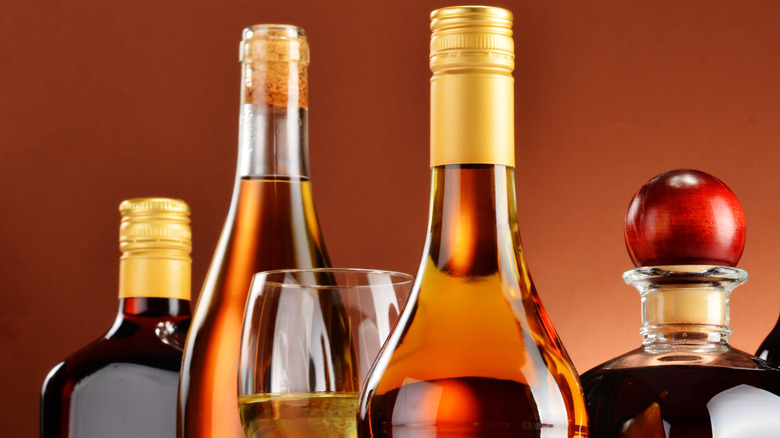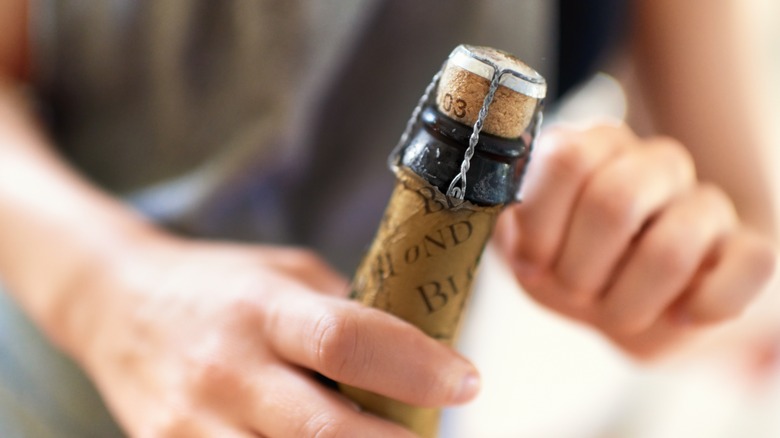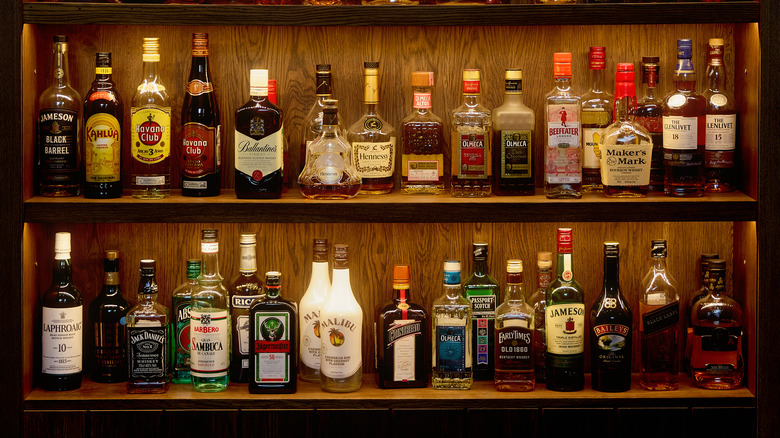Store Your Spirits Longer With A Weekly Cork Ritual
We usually think of "popping the cork" as a way to open up a bottle of wine, and usually a bottle of Champagne at that. But certain liquors also come with a cork in the top of the bottle, especially when it comes to whiskey or tequila. Now, corks are fairly sturdy and take a long time to degrade, but if you're planning on storing a bottle of liquor for a long time, then you should be aware: Corks can dry out over time.
This is less of a problem with cork-sealed wine bottles because they're stored on their side, and the wine keeps the cork moist. But you shouldn't store liquor bottles on their side (we'll get into why later). If you're not planning on drinking the spirit anytime soon, sommelier and liquor expert Jack Beguedou recommends shaking the bottle every now and then, according to an interview with Food & Wine. This can be done every week or every few months (which isn't a long time in liquor years) to keep a little moisture in the cork to keep it from drying out and crumbling.
Put a cork in it
To help put things into scale, a cork can usually last decades plugging up a bottle before it really starts disintegrating. Because spirits are usually around 35 to 40% ABV (alcohol by volume) at minimum, there's already some vapor hydrating the cork because of how strong the spirit is. Even so, when a cork begins degrading, the seal falters and air gets into the bottle which can cause oxidation. Oxidated alcohol tastes flat and flavorless, and even if spirits don't go bad, so to speak, their flavor can.
So, if the bottle-shaking trick helps keep liquor fresh, does it also work for wine bottles? It does, but it's not necessary because wine bottles are stored horizontally to keep the corks hydrated. With stronger liquors like spirits, you want to store the bottles upright because the constant contact between the spirit can damage the cork (it can also cause leaks if the bottle has a screw cap). Hence, shaking the bottle allows you to keep the cork moist with smaller, harmless amounts of liquor. Wine isn't strong enough to damage corks, so laying the wine bottle on its side solves the problem.
A long history of spirits (and wine)
It's difficult to tell when exactly a cork has dried out enough to let air in and begin "aging" the alcohol. There's no hard science beyond taking a sip of whatever's inside. However, if you've truly got an older vintage on your hands, and you're worried about the cork crumbling, it might be best to transfer the contents to a new bottle rather than give it a shake. If cork does crumble into your wine or spirits, it won't ruin the drink and can be easily filtered out — the only harm is how much it oxidized while the cork was degrading.
Corks are made from the bark of Quercus suber, fittingly called the cork oak tree, which is usually found in countries around the Mediterranean Sea. It's a popular myth that the famous Benedictine monk Dom Pérignon was the first to cork wine bottles in the 1600s, but they've possibly been used by ancient Romans as early as the 6th century BCE. They're used because they're porous but watertight, which means they can let a tiny amount of oxygen pass through and age the wine at a safe amount while keeping the liquid sealed inside. Just keep them slightly moistened to avoid them letting in too much.


